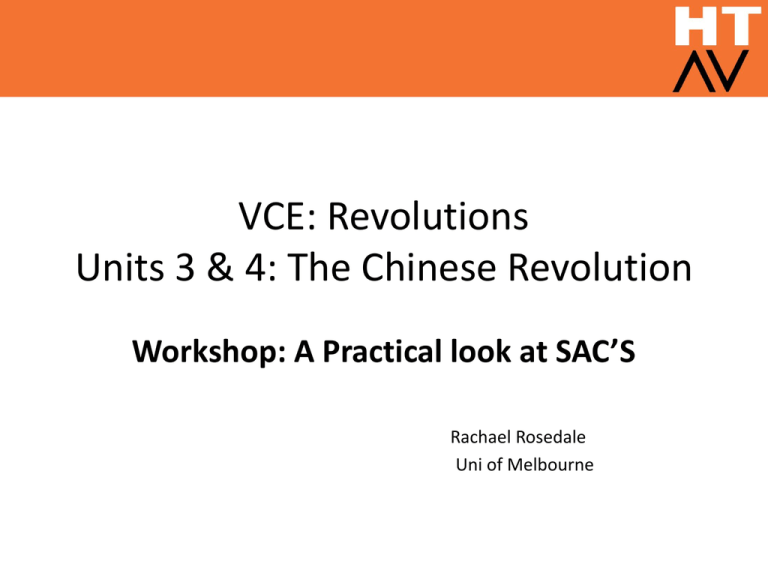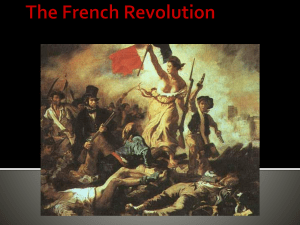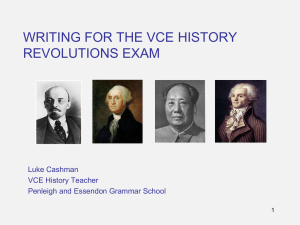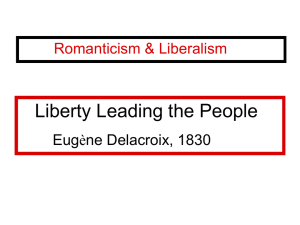VCE: Revolutions Units 3 & 4: The Chinese Revolution
advertisement

VCE: Revolutions Units 3 & 4: The Chinese Revolution Workshop: A Practical look at SAC’S Rachael Rosedale Uni of Melbourne Designing a SAC Task: My Approach: The SAC Tasks need to reflect the types of tasks students will be challenged with at the end of year exam. Gives students the opportunity to practise the knowledge & skills required to successfully complete the tasks throughout the year and for exam in order for them to achieve their best possible results. Gives students confidence in handling questions on exam paper. There are NO surprises. They get accustomed to the language of the study design, the exam and the examiner. They learn to ‘talk the talk’. Examiner’s report for 2011 Exam Paper General Comments “The students who performed best clearly noted the instructions for the questions, including specific question terms and timeframes. Unfortunately, many students needed to pay better attention to these aspects of the examination.” This can be achieved through structuring your SAC’s to reflect the types of questions asked and providing students with the opportunity to practise appropriate responses. The high achieving students in exam have superior skill sets because: They pay attention to wording of question They pay attention to visual/or document – Date, Author, Audience/Purpose They place the visual/or document in the context of the revolution (They must have knowledge of course of revolution) Designing your SAC’s to reflect the exam thus gives students practise, confidence and added advantage at the end of the year. Resources needed for designing a SAC 1. VCE History Study Design (2005-2014) For specific knowledge and skills required by students. www.vcaa.vic.edu.au/vce/studies/history/revolutions/revolutionindex.html 2. VCE History: Revolutions Assessment Handbook For types of assessment tasks and criteria for marking www.vcaa.vic.edu.au/vce/studies/history/revolutions/revolutionindex.html 3. Past Revolutions exam papers and examiner’s reports. For examples of types of questions & responses www.vcaa.vic.edu.au 4. Your School calendar. For appropriate placement of SAC’s within school year. 5. HTAV provide sample papers The VCE Revolutions Teacher Pack By Deborah Erikson & Allan Kerr Study Design sets the parameters for teaching & assessment. Key Knowledge & Key skills. Usually give a copy of Study Design to students at commencement of each Area of Study. Exam based on this document. Examiners must stick to guidelines of course and can’t ask anything else on paper. When setting SACs aim to target both key knowledge & key skills from study design. They should not be assessed separately (Study Design, p.134) Assessment should be part of regular teaching and learning program and must not unduly add to workload (Study Design, p.135). The SAC’s must be completed mainly in class within a limited timeframe (Study Design, p.135). When to assess? After topic has been taught or at end of semester? Task may assist in student’s learning development. Assessment Structure for Units 3 & 4 Examiners Report 2011: % of student choices for revolutions undertaken in exam. Section A – Revolution one Revolutionary ideas, leaders, movements and events Revolution chosen None America France Russia China % 0 11 50 32 7 Section B – Revolution two Revolutionary ideas, leaders, movements and events Revolution chosen None America France Russia China % 0 8 16 55 21 China Section B greatest % - Analysis of a Visual/or Written Document and Essay - Both include historiography component EXAMPLES OF ASSESSMENT TASKS: 1. ANALYSIS OF A VISUAL AND/OR WRITTEN DOCUMENT Area of Study 1 THE BOXER REBELLION a. Identify two details in the cartoon which suggest that the Boxer Rebellion is a popular movement. 2 marks b. Identify two ways the cartoon illustrates how foreigners were viewed in China. 2 marks c. Using your knowledge and the representation, explain the causes and consequences of the Boxer Rebellion. 6 marks d. Evaluate the usefulness of this representation in understanding the decline of the Qing dynasty and the progress of the Revolution. In your response refer to the representation and different views of the Revolution. 10 marks EXAMPLES OF ASSESSMENT TASKS: 1. ANALYSIS OF A VISUAL AND/OR WRITTEN DOCUMENT Area of Study 1 The historian Buggy,T., in his book The Long Revolution,(Shakespeare Head Press, NSW, pp44 - 47) says of the Qing reforms introduced after the Boxer Rebellion that, “Having made the decision, the Qing court set about implementing a comprehensive reform programme, which drew heavily on the proposals of Kang Youwei. The reforms, which affected education and the army as well as administration, were implemented with some flair and energy. At another time and in other circumstances they might have saved the regime, but by 1901 the mandate of heaven was moving away from the Qing, and the reforms had the opposite effect…………………. The role of each of these reforms can be clearly identified in the tensions which developed in China before the Wuchang Rebellion of 1911.” a. Identify the areas that the Qing was intending to reform. 2 marks b. Identify how these reforms would affect the Qing Dynasty. 2 marks c. Using your knowledge and quoting from the extract, explain how these Qing reforms contributed to the tensions and conflicts, which developed in China, before the 1911 Revolution. 6 marks d. Evaluate to what extent this extract provides a reliable view of the causes of the 1911 Revolution and the downfall of the Qing Empire. In your response quote from extract and refer to different views of the period 1901 to 1911. 10 marks Look carefully at the visual representation below and answer the questions. a. Identify the key figure depicted in the representation and of what importance is the role played by this key figure in the revolution? 2 marks b. Identify 2 other symbols in this representation which relate to the key figure? 2 marks c. Using your knowledge and the representation, explain how each symbol relates to the role of the key figure and the progress of the revolution? 6 marks d. Evaluate to what extent this representation is useful in understanding the rise of revolutionary ideas and leaders from 1927 to the final CCP victory in 1949. In your response refer to different parts of the representation and to different views of the Revolution. 10 marks Immanuel Hsu comments on the Second United Front a. Identify two reasons why the communists joined the Second United Front. 2 marks b. Identify two ways Mao hoped the Second United Front would benefit the spread of communism in China. 2 marks c. Using your knowledge and quoting from the extract, explain the ideas and events which necessitated the formation of a Second United Front. 6 marks d. Evaluate how useful this extract might be in explaining the victory of the Chinese Communist Party in 1949. In your response quote parts of the extract and refer to different views of the Revolution. 10 marks The Red Army during the Sino-Japanese War 1945 – 45 Carefully examine the Woodcut below and then answer the following questions. a. Identify two features in this woodcut of co-operation between the Red Army and the Chinese villagers? 2 marks b. Identify two of the ‘Eight Rules for the Red Army’ which are illustrated in this woodcut? 2 marks c. Using your own knowledge and the representation, explain the importance of Mao Zedong’s ideas in the success of the Red Army campaigns between 1935 and 1945? 6 marks d. Evaluate to what extent this representation provides a reliable depiction of the reasons for the success of the Chinese Communist Party over the Guomingdang by 1949? 10 marks EXAMPLES OF ASSESSMENT TASKS: HISTORIOGRAPHICAL EXERCISE Area of Study 1 Read extracts carefully and then answer the questions on the next page. a. Identify two threats to the Chinese way of life. 2 marks b. Identify two causes of hardship for the Chinese people. 2 marks c. By quoting from the extracts and using your own knowledge, explain the causes of the tensions and conflicts within Chinese society under the Qing from 1898 to 1911 6 marks d. Evaluate the usefulness of Sources A, B and C in understanding the factors which contributed to the downfall of the Qing and the Wuhan Revolution of 1911. In your response quote parts of the extract and refer to different views of the revolution. 10 marks Preparation Sheet for Outcome 1, Unit4: China You will need to know the following in order to prepare thoroughly for this outcome: 1. The Qing reforms introduced after the Boxer Rebellion 2. How they contributed to the revolution? 3. Were there other causes of tension and conflict in the Old Regime, which caused the 1911 revolution? (Long and short term) 4. What do different historians say about the causes of the 1911 revolution? VCE HISTORY: REVOLUTIONS UNIT4: CHINA Area of Study One: Revolutionary Ideas, Movements and Events Outcome One: PART A: A Historiographical Exercise NAME: _______________________________________________________ Total Marks: 20 Writing Time: 50 minutes Date: 26/06/10 Venue: R302 Instructions 1. 2. There are 4 questions to be answered. Read each question carefully. Answer the question in the space provided below it. Assessment Criteria 1. 2. 3. 4. 5. Knowledge of a range of events and factors which developed during the course of the revolution. Causes of tensions and conflicts generated in the old regime that contributed to its breakdown. Analysis of the importance of ideas, ideologies, individuals and groups in bringing about revolutionary change. Synthesis of written and visual sources to draw conclusions. Consideration of a range of historian’s interpretations. This is one component of SAC in this subject. All SACs will be statistically moderated by VCAA. Performance Descriptors as per Assessment Handbook. Outcome 1 : Evaluate the role of ideas, leaders, movements and events in the development of the revolution Knowledge of a range of events and factors which developed during course of the revolution. Identification and analysis of the causes of tension and conflicts generated in the old regime that contributed to its breakdown Analysis and evaluation of the importance of ideas, ideologies, individuals and groups in bringing about revolutionary change. Analysis and evaluation of evidence that synthesises a range of written and visual sources. Analysis and evaluation of historians’ interpretations Performance Descriptors as per Assessment Handbook. Outcome 2: Analyse the challenges facing the emerging new order, the way in which attempts were made to create a new society, and evaluate the nature of the society created by the revolution. Knowledge of the contribution of ideologies and groups in the creation of the new society. Analysis of the challenges faced by revolutionary individuals, groups, governments or parties and their responses. Evaluation of the nature of society created by the revolution and the changes and continuities that it brought about. Analysis and evaluation of evidence that synthesises a range of written and visual sources to draw conclusions. Analysis and evaluation of historians’ interpretations. EXAMPLES OF ASSESSMENT TASKS: ESSAY Essay Topics 1. The Chinese Revolution ‘devoured its children’ between 1949 and 1976. Discuss. Provide evidence to support your answer. 2. Several historians argue that Mao Zedong’s legacy was one of death and destruction – one that completely destroyed Chinese society and left well over 70 million people dead. Did Mao’s rule from 1949 until 1976 bring any benefit to Chinese society? Use evidence to support your answer. (2011 paper) 3. Mao once said that “political power grows out of the barrel of a gun.” Does this statement reflect the development of the new society in China after 1949? Provide evidence to support your answer. ( Insight, Trial Paper, 2010) OUTCOME TWO: ESSAY PREPARATION Criteria 1. demonstrate the knowledge of the importance of ideologies, individuals and groups, governments or parties in the creation of the new society. 2. analyze the challenges faced by revolutionary groups and analyze the ways in which they respond to them. 3. evaluate the degree to which the revolution brought about changes and continuities. 4. analyze and synthesize written and visual sources to draw conclusions. 5. consider a range of historians’ interpretations. Discuss: What does this mean? To investigate or examine by argument, sift and debate, giving reasons for and against. Planning your essay: Questions to ask? (use your thinking skills) 1. What was the new society like after 1949? 2. What problems did the CCP immediately face and what did they do to address these and how then did they change the nature of the society? 3. Impact of these changes on different classes of society – peasants, landlords, business, middle classes, city workers, intellectuals etc. 4. Was the impact good or bad? What is your opinion? 5. Was everyone happy with these changes to society? Who wasn’t? 6. What crises did the CCP face in the 50’s, 60’s, & 70’s? 7. Did the revolution devour its own children and when? Ways to Plan: A flow chart, a fish diagram or a mind map on an A3 sheet of paper would be a good way to collect, collate and synthesis your thoughts, as well as summarize this area of study to use for the exam. Introduction • Must address the topic • Set your limits as this essay covers a very big section of time – from1949 to 1976. What were the problems/challenges faced? (political, economic & social) What are you going to deal with? • First sentence should be informative and catchy in order to capture the reader’s attention. It probably should say something about communist take over and/or nature of the new society and /or revolutions devouring children. • Should include what your main position is on the proposition. Do you agree or disagree with the statement? Your opinion in other words? Impact of changes on groups or classes? (briefly) • Should include a structure for your essay by signposting the points you intend to cover to support your opinion or argument. What crises are you going to deal with? Body • Contains a series of paragraphs that provide evidence to support your argument. • Each point should follow a similar path. You could follow the PEEL pattern for each paragraph. P- Make your point. E – Explain. E – evidence. L – link your paragraph back to the question and/ or the next paragraph. • Each paragraph should explain why this event is perceived as a crisis in achieving the new society. • Each should evaluate the seriousness and nature of the crisis. Did the crisis devour its children? • Each should make reference to historian’s viewpoints or interpretations of the crisis and /or a problem of history. (must be in body of essay) • Use quotes liberally throughout essay. (not just what leaders said but what historians say). • Crises might include 100 flowers, GLF or GPCR. Conclusion Your conclusion should briefly reiterate the main point of each section of your essay and restate your overall opinion or argument. Essay Topic “The Chinese Revolution ‘devoured its children’ between 1949 and 1976.” Discuss. Provide evidence to support your answer. Changes during the 50’s Political: Common programme, government structure, role of PLA and division of country. Economic: Land reform, nationalization of banks and industry, 1st Five year plan. Social: Marriage Law Act, Thought Reform, Mass Campaigns, mutual aid teams, lower and higher stage co-operatives and communes. Main crises: 100 Flowers and GLF Changes during the 60’s Political: Mao’s stepping down and withdrawal from everyday government, rise of Moderates. Economic: Disbanding of communes and other reforms made by Moderates. Social: Use of culture to criticize leadership – ‘Dismissal of Hai Rui’ and effects. Social Education Movement introduced by Mao. Main crisis: GPCR Changes in mid 60’s and 70’s Political: Lin Biao takes charge of PLA, publication of ‘Little Red Book’ and its effects on PLA, Mao’s comeback by launching Cultural Revolution, formation of Red Guards and their effects, attack on Moderates and removal of Liu Shaoqi and Deng Xiaoping. Social: Four Olds Campaign and the effects of Red Guards on society. Struggle sessions, class warfare and ‘Capitalist roader’ campaign. Economic: Ten years of Chaos, effects of GPCR on economy. VCE HISTORY REVOLUTIONS UNIT 3: RUSSIA OUTCOME 2: RESEARCH REPORT Analyse the challenges facing the emerging new order, and the way in which attempts were made to create a new society, and evaluate the nature of the society created by the Revolution. Research will be in two parts: Assessment: PART A. Research report and Bibliography PART B. Written response (SAC) 30 marks 20 marks 50 Total Marks Dates for submission PART A. Allocated class time for individual research: Insert date Submission of Report and Bibliography: Insert date PART B. SAC date for written response (60 minutes): Insert date Criteria Knowledge of the contribution of ideologies, individuals and groups in the creation of the new society. Knowledge and analysis of the challenges faced by revolutionary individuals, groups, governments or parties and their responses. Evaluation of the nature of the society created by the revolution and the changes and continuities that it brought about. Evaluation of evidence that synthesises a range of written and visual sources to draw conclusions. Analysis and evaluation of historians’ interpretations. This assessment is one component of SAC in this subject. All SACs will be statistically moderated by VCAA. ASSESSMENT TASK: RESEARCH REPORT PART A: Research Report and Bibliography AIMS: To investigate the importance of ideologies, individuals and groups, governments or parties in the creation of the new society. To investigate and analyse the challenges facing the emerging New Order. To investigate the responses of the New Order to these challenges. To evaluate the nature of the new society – What degree of change took place and what continued from the Old Regime? To investigate and analyse whether or not the revolutionaries achieved their goals or ideals? METHOD: Over a two-week period you are to use allocated class time to collect evidence (from at least 4 different sources) and prepare a 700 - 800 word response for three of the challenges (crises) facing the emerging New Order listed below. For each challenge your response must include answers to the prescribed questions below. CHALLENGES: Problems facing the Communist Government between 1949 to 1955 The Hundred Flowers Campaign The Great leap Forward The Great Proletariat Revolution QUESTIONS TO INVESTIGATE: What were the events contained in this crisis and why was it seen as a crisis? Which ideas, individuals, groups or governments were involved? How did the New Order respond to this crisis? What degree of change to the nature of the new society did this crisis/response create? What degree of continuity from the Old Regime did this crisis/response contribute to the nature of the new society? What do different Historians’ say about this crisis/response and its contribution to the creation of a new society? Did this crisis/response help or hinder the revolutionaries’ goals/ideas about the nature of the new society they hoped to create? PRESENTATION: You will present your findings as a set of responses (700 – 800 words each) to the prescribed questions above. You will also include a Bibliography with your responses. ASSESSMENT: PART A is worth 30 marks and is to be submitted no later than ………. Your research will form the basis for your written response, which will be completed under SAC conditions in class on ………. This response will be between 400 to 600 words and completed in 60 minutes and is worth 20 marks. The completed task will be allocated a total score of 50.









